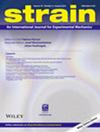High strain rate elasto‐plasticity identification using the image‐based inertial impact (IBII) test part 2: Experimental validation
IF 1.8
3区 材料科学
Q2 MATERIALS SCIENCE, CHARACTERIZATION & TESTING
引用次数: 4
Abstract
Current high strain rate testing techniques typically rely on the split‐Hopkinson bar (SHB). The early response in an SHB test is corrupted by inertia making it difficult to accurately characterise the transition from elasticity to plasticity for metals. Therefore, a new test method is required. This article is the second in a two‐part series which aims at developing a new high strain rate test for elasto‐plasticity identification using the image‐based inertial impact (IBII) method. The goal of this article is to validate the new method experimentally using IBII tests on aluminium 6082‐T6 (minimal rate sensitivity) and stainless steel 316L (rate sensitive). Comparison of the quasi‐static and dynamic stress–strain curves for the aluminium case showed minimal difference providing experimental validation of the method. The same comparison for the steel showed that the method was able to detect rate sensitivity.使用基于图像的惯性冲击(IBII)试验的高应变速率弹塑性识别第2部分:实验验证
目前的高应变率测试技术通常依赖于劈裂霍普金森杆(SHB)。SHB试验的早期响应受惯性影响,难以准确表征金属从弹性到塑性的转变。因此,需要一种新的测试方法。本文是两部分系列文章中的第二部分,该系列文章旨在利用基于图像的惯性冲击(IBII)方法开发一种新的高应变率测试,用于弹塑性识别。本文的目的是通过IBII测试在6082‐T6铝(最小速率灵敏度)和316L不锈钢(速率灵敏度)上验证新方法。铝壳的准静态和动态应力-应变曲线的比较表明差异很小,为该方法提供了实验验证。对钢进行了同样的比较,表明该方法能够检测出速率灵敏度。
本文章由计算机程序翻译,如有差异,请以英文原文为准。
求助全文
约1分钟内获得全文
求助全文
来源期刊

Strain
工程技术-材料科学:表征与测试
CiteScore
4.10
自引率
4.80%
发文量
27
期刊介绍:
Strain is an international journal that contains contributions from leading-edge research on the measurement of the mechanical behaviour of structures and systems. Strain only accepts contributions with sufficient novelty in the design, implementation, and/or validation of experimental methodologies to characterize materials, structures, and systems; i.e. contributions that are limited to the application of established methodologies are outside of the scope of the journal. The journal includes papers from all engineering disciplines that deal with material behaviour and degradation under load, structural design and measurement techniques. Although the thrust of the journal is experimental, numerical simulations and validation are included in the coverage.
Strain welcomes papers that deal with novel work in the following areas:
experimental techniques
non-destructive evaluation techniques
numerical analysis, simulation and validation
residual stress measurement techniques
design of composite structures and components
impact behaviour of materials and structures
signal and image processing
transducer and sensor design
structural health monitoring
biomechanics
extreme environment
micro- and nano-scale testing method.
 求助内容:
求助内容: 应助结果提醒方式:
应助结果提醒方式:


